1993 BUICK ROADMASTER trailer
[x] Cancel search: trailerPage 82 of 340
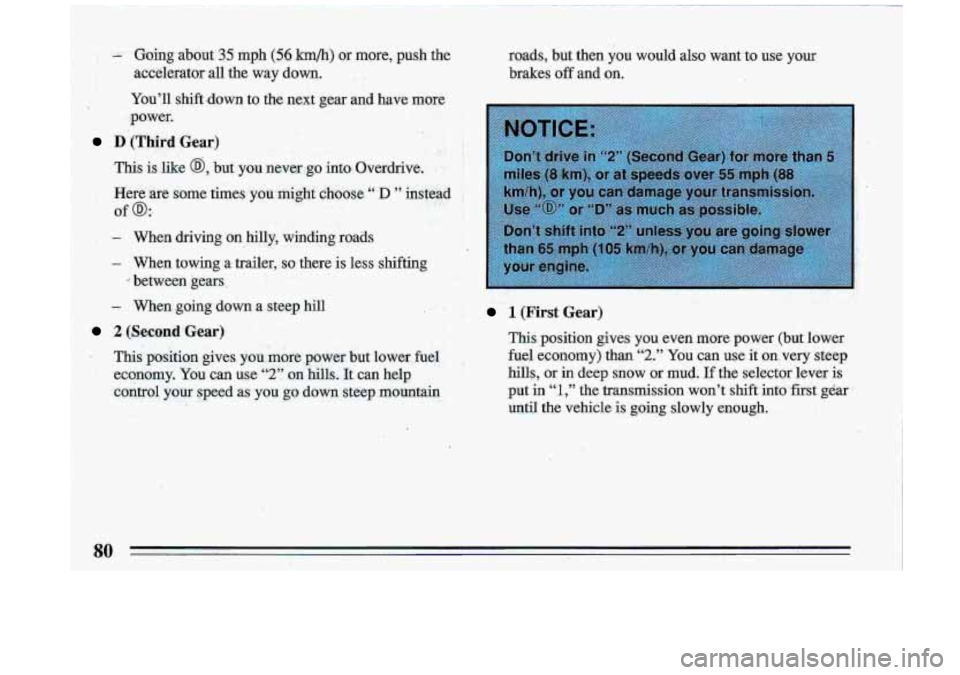
-. Going,about 35 mph (-5.6 km/h) or more, push the
accelerator all the way do.wn.
. .
You’ll shift,down to the next gear and have more
power.
D.(Third Gear)
This is like @, but you never.go into-Overdrive. - .
Here ’ue some tirnes kowmight dboose “ D ” instiad
of a:. -,
.. - When driving on hilly, winding roads
- When towing a- trailer, so there is less shifting
- When .going down a steep hill . . . !A
J between gears.
2 (Second Gear)
. This position gives you.more ,power but lower fuel
ecanomy. You can use
“2’’ on hills..Zt can help
cohtrol your
speed as. you go down steep mountain roads, but
then-you would also want
to use your
brakes
off and on.
1 (First Gear)
This position gives you even more power (but lower.
fuel economy) than
“2.” YOU can use it on,very steep
hills, or in deep snow or mud.
If the selector lever is
put in
“1,” the transmission won’t shift into first gear
until the vehicle is going slowly enough.
Page 84 of 340
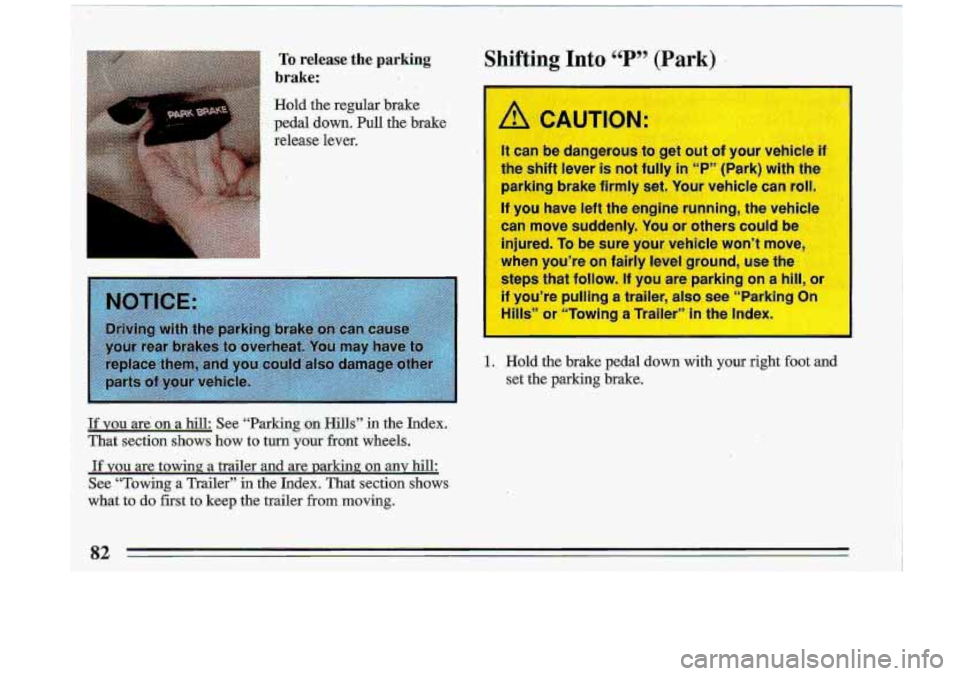
,. To release the parking
brake:
Hold the regular brake
pedal down. Pull the brake
release lever.
,.( r
Jf YOU are .on a hill: See “Parking on Hills” in the Index.
That section
shows how to turn’ yoax front wheels.
If you are towinp a trailer and are.parking’on any hin:
‘See
“Towing a Trailer” in the Index. That section shows
:what
to do first to keep the trailer from moving.
. .(*
Shifting Into P (Park)
ci 99
It can be dangerous to get out of your vehicle if
the shift lever is not fully in T” (Park) with the
parking brake firmly
set. Your vehicle can roll.
If you have left the engine running, the vehicle
can move suddenly. You or others could be
, injured. To be sure your vehicle won’t move,
when you’re
on fairly level ground, use the
steps that follow.
If you are parking on a hill, ~r . 11
if you’re pulling a trailer, also see “Parking Or-.
Hills” or “Tcl ..:nu a Trailer” in the Index.
I
1 .. Hold the brake pedal down with your right foot and
set the parking brake.
Page 92 of 340

As you signal a turn or a lane change, if the arrows don't
flash but just stay on, a signal bulb may be burned out
and other drivers won't see your turn signal.
If a bulb is burned out, replace it to help avoid an
accident. If the green arrows don't go on at all when you
signal a turn, check the fuse (see "Fuses" in the Index)
and for burned-out bulbs.
If you have a trailer towing option with added wiring for
the .trailer lights, a different
turn signal flasher is used.
With this flasher installed, the signal indicator will flash
even if
a turn signal bulb is burned out. Check the front
and rear turn signal lights regularly to make sure they
are working.
Turn Signal Reminder
A chime will sound if your turn signal remains on after
having driven
1/2 mile, to remind you to turn off your
signal.
Operation of Lights
Although your vehicle's lighting system (headlamps,
parking lamps, fog lamps, side marker lamps and tail
lamps) meet all applicable Federal lighting
requirements, certain States and Provinces may apply their own lighting regulations that may require special
attention before you operate these lamps. For.example,
some jurisdictions may require that you operate your
lower beam lamps with fog lamps at -all times, or that
headlamps. be turned
on whenever you.must use your
windshield wipers. In addition, most jurisdictions
prohibit driving solely with parking lamps, especially at
dawn or dusk. It is recommended that you check with
you own State or Provincial highway authority. for
applicable lighting regulations.
Headlight High-Low Beam
To change the headlights.
l .from low beam to high or..'
:hi:& -to low, pull the turn
signal lever all the way
'toward you. Then .release it.
When the high beams are
on, a blue light, on the
instrument panel -also will
be on.
90
Page 153 of 340
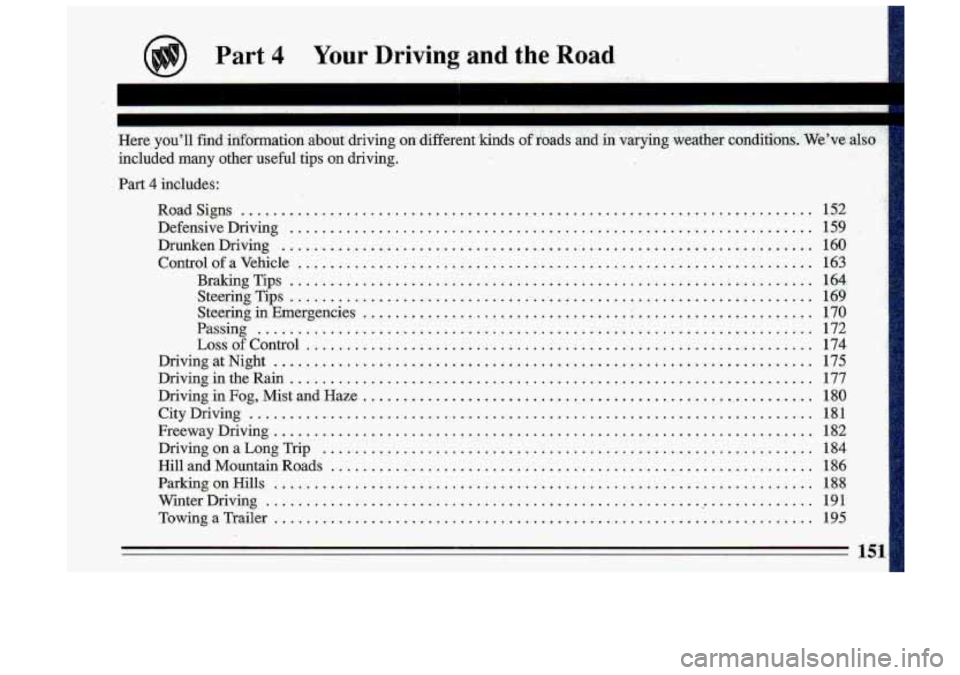
Part 4 Your Driving and the Road
Part 4 includes:
RoadSigns
........................................................................\
DefensiveDriving .................................................................
DrunkenDriving ...................................................................
ControlofaVehicle ................................................................
BrakingTips .................................................................
SteeririgTips .................................................................
Steering in Emergencies ................................. I ......................
Passing .....................................................................
Loss of Control ...............................................................
DrivingatNight ...................................................................
DrivingintheRain .................................................................
Driving in Fog, Mist and Haze .........................................................
FreewayDriving ....................................................................
DrivingonaLongTrip ..............................................................
Hill and Mountain Roads ............................................................
ParkingonHills ...................................................................
WinterDriving .....................................................................
CityDriving ......................................................................
TowingaTrailer ...................................................................
Page 197 of 340
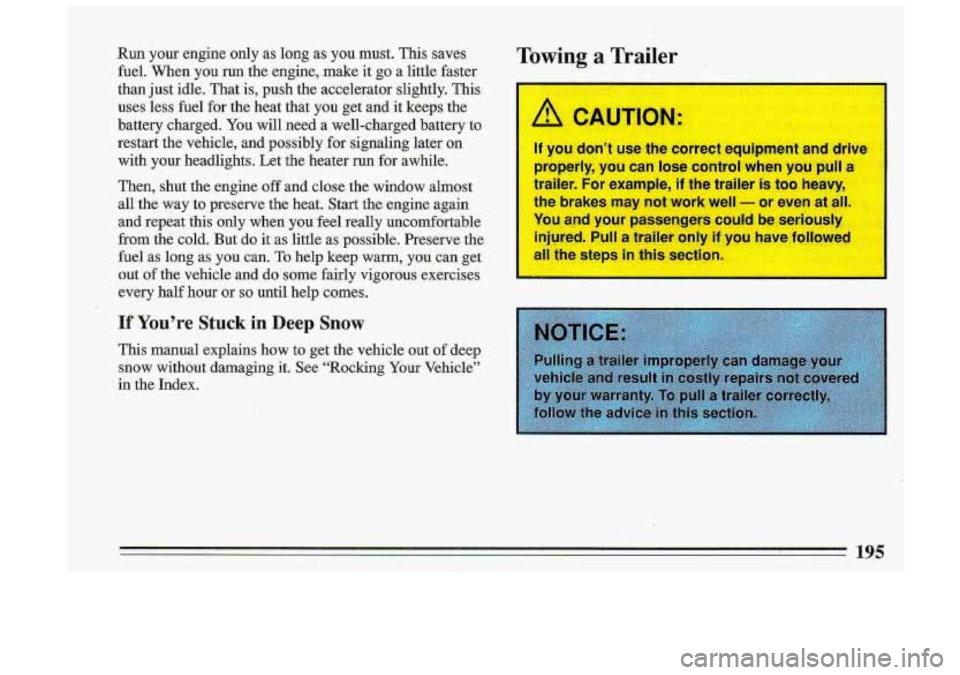
Run your engine only as long as you must. This saves
fuel. When you
run the engine, make it go a little faster
than just idle. That is, push the accelerator slightly. This:
uses less fuel for the heat that you get and it keeps the
battery charged.
You will need a well-charged battery to
restart the vehicle, and possibly for signaling later
on
with your headlights. Let the heater run for awhile.
Then, shut the engine
off and close the window almost
all the way to preserve the heat. Start the engine again
and repeat this only when you feel really uncomfortable
from the cold. But do
it as 'little as possible. Preserve the
fuel
as long as you can. To help keep warm, you can get
out of the vehicle and
do some fairly vigorous exercises
every half hour or
so until help comes.
Towing, a Trailer
/! CAUTION-
If you don't use the correct equipment and drive
properly, you can lose control when you
pull a
trailer.
For example, if the trailer is too heavy,
I the brakes may not work well - or even at all,
You and your passengers could be seriously'
injured. Pull
a trailer only if you have followed
I the steps in this section.
Page 199 of 340

Weight of the Trailer
How heavy can a trailer safely be? load from
your vehicle’s capacity weight because your
vehicle will be carrying that weight, too. See “Loading
’
Your Vehicle” in the Index for more information about
,.
It should never weigh more than 2,000 pounds (900 kg), your vehicle’s maximum load capacity.
unless you have the optional
5,000 pound (2,250 kg)
trailer towing package. But even that can be too heavy.
,.
. . 8:
It -depends on how you plan to .use your rig. For
example, speed, altitude,,road grades, outside
. . .
temperatuie and how much your vehicle is us.ed to pull a
trailer ‘are .all important. And,
it can also depen‘d on any
special equipment that you have on your vehicle.
.’
You can ask your dealer for our traiIering information or
advice, or
you can write us at Buick Motor Division,
Customer Assistance .Center;
902 E. Hamilton Avenue,
Flint,
M.148550.
,.
In Canada, write to General Motors ,of Canada Limited,
Customer Assistance Center, 1908 Colonel Sam. Drive,
Qshawa, Ontario
LlH 8P7.
Weight of the Trailer Tongue
The tongue load (A) -of any trailer is an important
weight to measure because it affects the total capacity
weight of your vehicle. The capacity weight includes ‘the
curb weight’ of the vehicle, any cargo you may carry in
it, and the people who will .be riding in the vehicle. And
if you will
~QW a trailer, you must subtract the tongue
If you’re using a “dead-weight” hitch, the trailer tongue
(A) should weigh 10% of the total loaded trailer weight
(B).
If you have a “weight-distributing” hitch, the trailer
tongue
(A) should weigh 12% of the total loaded trailer
weight
(B). - ’
After you’ve lo,aded.your trailer, weigh the trailer and
then the tongue, separately,
to. see if the weights are
proper. If they aren’t, you may be able’ to get them tight
simply by moving some
items around in the trailer.
Page 200 of 340
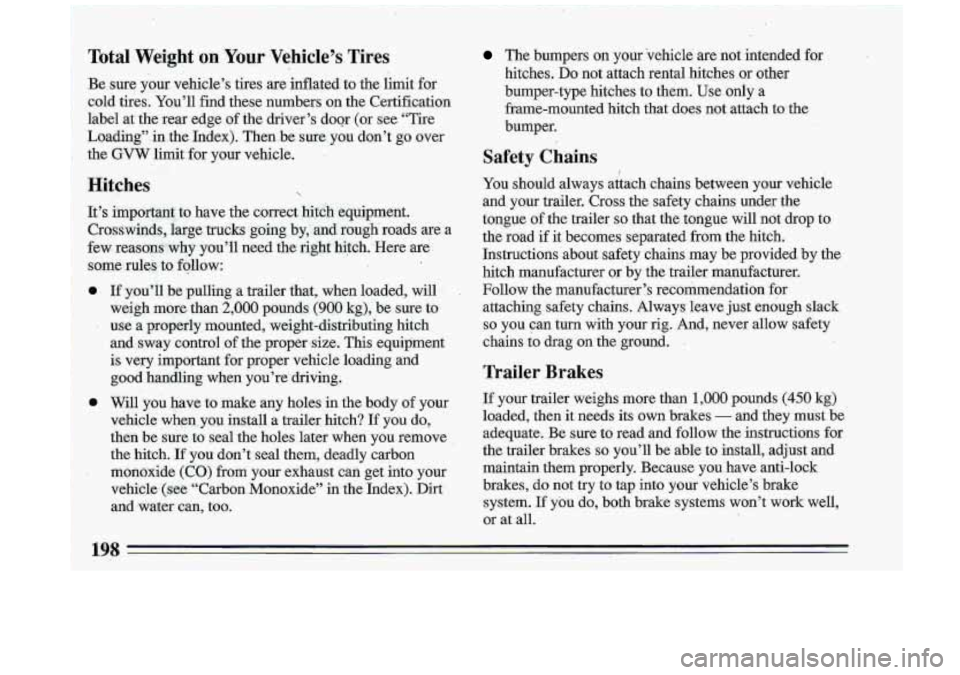
Total Weight on Your Vehicle’s Tires
Be sure your vehicle’s tires are inflated to the limit for
cold tires. You’ll find these numbers on the Certification
label at the rear edge
of the driver’s doqr (or see “Tire
Loading” in the Index). Then be sure you don’t go over
the
GVW limit for your vehicle.
Hitches
It’s important to have the correct hitch equipment.
Crosswinds, large trucks going by, and rough roads are
a
few reasons why you’ll need the right hitch. Here are
some rules to follow:
0
0
If you’ll be pulling a trailer that, when loaded, will
weigh more than
2,000 pounds (900 kg), be sure to
use a properly mounted, weight-distributing hitch
and sway control of the proper size. This equipment
is very important for proper vehicle loading and
good handling when you’re driving.
Will you have to make any holes in the body of your
vehicle when you install
a trailer hitch? If you do,
then be sure to seal the holes later when you remove
the hitch. If you don’t seal them, deadly carbon
monoxide (CO) from your exhaust can get into your
vehicle (see “Carbon Monoxide” in the Index). Dirt
and water can, too.
The bumpers on your vehicle are not intended for
hitches.
Do not attach rental hitches or other
bumper-type hitches to them. Use only a
frame-mounted hitch that does not attach to the
bumper.
Safety Chains
You should always attach chains between your vehicle
and your trailer. Cross the safety chains under the
tongue of the trailer
so that the tongue will not drop to
the road
if it becomes separated from the hitch.
Instructions about safety chains may be provided by the
hitch manufacturer or by the trailer manufacturer.
Follow the manufacturer’s recommendation for
attaching safety chains. Always leave just enough slack
so you can turn with your rig. And, never allow safety
chains
to drag on the ground.
Trailer Brakes
If your trailer weighs more than 1,000 pounds (450 kg)
loaded, then it needs its own brakes
- and they must be
adequate. Be sure to read and follow the instructions for
the trailer brakes
so you’ll be able to install, adjust and
maintain them properly. Because you have anti-lock
brakes, do not try to tap into your vehicle’s brake
system.
If you do, both brake systems won’t work well,
or at all.
198
Page 201 of 340

Driving with a Trailer
Towing a trailer requires a certain amount of experience. Before setting out for the open road, you’ll want to get
to
know your rig. Acquaint yourself with the feel of
handling and braking. with the added weight of the
trailer. And always keep in mind that the vehicle you are
driving is now
a good deal longer and not nearly so
responsive as your vehicle is by itself.
Before you start, check the trailer hitch and platform,
safety chains, electrical connector, lights, tires and
mirror adjustment.
If the trailer has electric biakes, start
your yehicle and trailer moving and then apply the
trailer brake controller by hand to be sure the- brakes are
working. This lets you check your electrical connection
at the same time.
During your trip, check occasionally to
be sure that the
load
is secure, and that the Lights.and any trailer brakes
are .still working.
Following Distance
Stay at least twice as far behind the vehicle ahead as you
would when driving your vehicle without a trailer. This
can help
you avoid situations that require heavy braking
and sudden turris.
.
Passing
You’ll need. more passing distance up ahead when
you’re towing a trailer. And, because you’re a good deal \
longer, you’ll need to go much farther beyond the
.
passed vehicle before you can return to your lane.
Backing Up
Hold the bottom of the steering wheel with one hand.
Then, to move the trailer
to the left, just move that hand
to the left.
To mo.ve the trailer to the right, move your
hand to the right. Always back up slowly and, if
possible, have someone guide
you.
Making Turns
When you’re turning with a trailer, make wider turns
than normal.
Do this so your trailer won’t strike soft
shoulders, curbs, road signs, trees, or other objects.
Avoid jerky or sudden maneuvers. Signal well in
advance.
Turn Signals When Towing a Trailer
When you tow a trailer, your vehicle has to have .a
different turn signal flasher and extra wiring. The green
arrows on your instrument panel will
flash whenever
you signal a
turn or lane change. Properly hooked up,
199